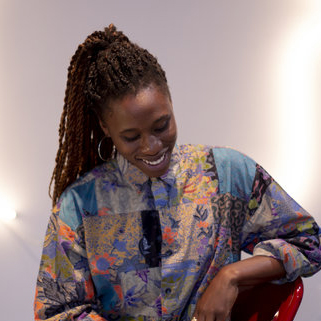By Jo Mikula, Co-Editor-in-Chief
Visual artist and researcher Mimi Onuoha’s exhibit at the Haverford Visual Culture, Arts, and Media (VCAM) center is destabilizing—and this is precisely her intention. The exhibition opens with a panel of text that explains the premise of the exhibition, with nearby pamphlets providing additional historical background. A speaker, the auditory component of the exhibition, is suspended from the ceiling in the middle of the room, piping music so quietly that you have to strain to hear it consciously.
Finally, five hand-made prints hanging in a row on the far wall, the apparent focal point of the exhibition. And yet, there is no wall text to accompany them. We are left to contemplate portraits that present data and images, but refuse to do interpretive work for us. The absence of context is a highly intentional choice on Onuoha’s part. “I didn’t want there to be a God’s view, a God’s eye,” Onuoha said at a talk at the VCAM. “There’s a discomfort in not providing text or explanation.”
Entitled In Absentia, the exhibit is the first in a new series from Onuoha that examines data and its absences. In Absentia takes inspiration from renowned black academic W.E.B. Du Bois’ sociological work on the political and economic standing of black communities in Lowndes County, Alabama.
The story of this particular sociological study is a sobering reminder of the limits of data. In the early 1900s, the Federal Bureau of Labor Statistics commissioned Du Bois and a team of twelve researchers to create a report on Lowndes County that the Bureau would then publish. Du Bois and his team traveled to Alabama, where they interviewed black farmers in Lowndes County on a number of subjects. These included land ownership, political activity, morality, and family life. The final manuscript, completed in 1907, was the most intense study of black life in the U.S. to that date.
A year after sending in the manuscript, Du Bois learned that the Bureau had decided not to publish the report because they deemed the factual content of the piece to be too inflammatory. The Bureau had destroyed Du Bois’ manuscript, the only copy of the work.
Onuoha was captivated by this story. “We think of data as a novel tool for social justice,” she said. “But our belief in data as empirical proof is disrupted by this story. Because when [the Bureau] has a stake in the results and they don’t like the results, they reject it.”
In Absentia is Onuoha’s response to this story. She has designed the five prints in the exhibition in the visual language of Du Bois’ report, but rather than embodying data visualization, the prints gesture to a different type of knowing. According to Onuoha, “they are meant to get at the space of things that are absent, that are difficult to talk about.”
The audio element of the exhibition is another way to address the question of absence. Onuoha is very drawn to archival work, particularly to questions about what counts as an archive. “So often oral stories are not counted as something that can be saved in an archive,” she noted. The audio installation pushes back against this idea, asserting the place of oral histories in the archive.
Onuoha’s use of art to examine the role of data is in large part due to her professional background working with it. Before pursuing art, she was a data journalist with the online news outlet Quartz.
One of her biggest pieces at Quartz was an examination of places that do not show up on Google Maps. For instance, only 26 of the 1,000 favelas in Rio de Janeiro are mapped, a phenomenon also seen with settlements in Mongolia and Chad. The lack of digital data for these places can have serious consequences. Many Brazilian favelas, for example, do not receive social services like mail, garbage collection, or electricity because they are not on the map.
But Onuoha cautions that her goal is not simply to collect more data. “I’m interested in larger structural questions,” she said. “What does accessibility of data produce?” These larger structural questions are essential in light of the Du Bois study that the American Government explicitly destroyed. It is not always enough to have data. If data contradicts the structural interests of those in power, it may not be as effective as we would like to think.
Onuoha and her exhibit came to Haverford as part of the college’s cross-disciplinary Technology and Justice series. Through a sequence of workshops, speakers, roundtables, and exhibitions, this series seeks to examine the ways that technology and data collection can both stimulate and hamper social justice movements. Informed by the understanding that technology is based in social, racial, and economic spaces, the series highlights the social dynamics behind data collection and the ways that people and bodies may be differently abstracted through data, or missed entirely.
“Data is a powerful way to know the world. But it is only one way,” Onuoha writes in the booklet that accompanies her exhibition. “The problem with a society that prioritizes knowing the world through data is that it eliminates the many other forms of knowing.”
In Absentia seeks to recover some of these other forms of knowing. It is not a simple process, and there is no blueprint for this recovery work; but it is essential. As Onuoha said toward the end of her visit, “I think it was Teju Cole on Toni Morrison who said something like, ‘you can trace the outline but you can’t quite get at the thing. And that’s enough.'”
The Technology and Justice Series will continue throughout the spring semester.
Image Credit: Haverford College
